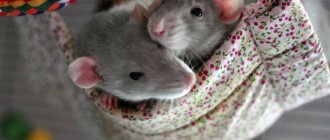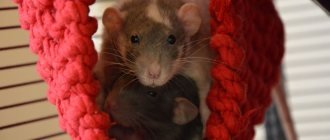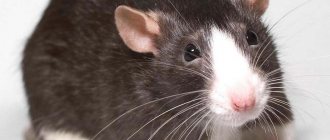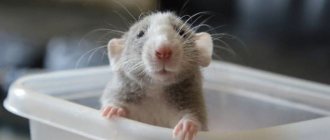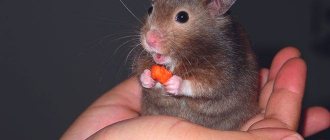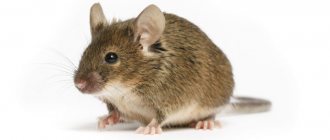Rats are the largest rodents from the mouse family, which are one of man's long-time neighbors. These animals can be found in almost every corner of the planet. They are even inhabitants of islands located far from the mainland. Rodents can have different coat colors and even different colored eyes. This article will tell you which types of rats are the most common.
Not every person knows what kind of rats there are. Many people divide these animals into outdoor and ornamental. However, in nature there are about 70 species of gnawing animals, which differ in appearance, size and habitat. Thus, the palm rat, which lives on palm trees, lives on the Nicobar Islands; forest rodents are common in the forests of Mexico and the USA. The fuzz rat is distinguished by its soft and barely noticeable fur.
There are also mammals with a flat tail and animals without one. Curly-haired rats are very attractive; long-eared rats are distinguished by their originality. But perhaps the most famous representatives of the rat family are the black, gray, Turkestan, black-tailed and fluffy-tailed rabbit rats. Photos of rat species can be seen below.
Types of rats
Gray rat
The gray rat (pasyuk) is one of the most common species of rodents, living in almost all corners of the planet: in many European countries, Canada, and the northern USA. Animals are not adapted to life only in polar latitudes. Pasyuki prefer to live in rural areas near large domestic animals, using their food for food. Under natural conditions, they settle where there is access to water. They feed on birds, their eggs and chicks, as well as voles and carrion.
You can also meet gray rats in the city. Their favorite habitats are basements, garbage chutes, warehouses, and various outbuildings. That is why gray rats are also called barn rats.
The appearance of a rat is familiar to many. The body length of the animal is about 25 cm, the tail is always shorter (does not exceed 20 cm). Pasyuki's fur, in comparison with their relatives, is coarser and tougher. Coat color can vary from gray to red tones. In many respects it also depends on age: in young individuals the coat is usually light gray in color, but with age it turns red. In connection with this, even a brown rat is often found. A clear border of colors is visible on the pasyuk’s light belly. The wide and blunt muzzle has light mustaches, pinkish slightly pointed ears and small black eyes.
On a note!
Gray rats are highly fertile: up to 5-8 litters can be born in a year, each with 7-10 pups.
Varieties by coat type
The standard type of fur in a rat is gray, short, shiny, and other types are also distinguished:
- Curly-haired rats or rexes have dense, curly fur, less pronounced on the belly. It is rougher and tougher to the touch, the whiskers of this species are slightly curled and shorter than those of the standard. Rexes have wider ears and a bushier tail. Rats are easy to train, affectionate and playful, and therefore enjoy deserved popularity among hobbyists. This species is clean and loves swimming.
- Wavy or corduroy rats have thick, slightly curly fur that runs in waves, which from a distance may look like ruffled "feathers", but is softer to the touch.
- Fuzz rat - this species has practically no hair, and the skin is covered with thin short fluff, which takes on a shade of white or gray depending on the lighting. The down on the face and belly is longer and denser, which is why they are called “downy”. The ears are round in shape, slightly pressed to the head. Only highly professional breeders breed such rats.
- The Sphynx or hairless rat, bred by mutation, has virtually no fur, with sparse hairs found on the abdomen, head or paws. The skin is gathered into folds and has a pink color without spots. The Sphynx's ears are slightly larger than those of the standard species. Due to artificial breeding, this type of rodent has health problems, various nuances in nutrition and care: they need warm air and the absence of drafts. The size depends on the breed of rat, usually 10-25 cm.
- Double Rex or pseudo-Sphynx - animals are covered with fur in areas, and bare areas can change with furry ones during life.
- Satin or satin rats are distinguished by thin, silky fur that is longer, which is why they are also called long-haired. The breed was recently developed in the USA and is not standardized. The colors are varied, unpretentious in maintenance and nutrition, friendly and curious. Body size – 8-30 cm.
Black rat
Black rat
This type of rat is no less common. Black rodents live in Europe and Asia; they are also found on the American, Australian and African continents.
Black rats are inhabitants of megacities. They prefer to live on the upper floors of high-rise buildings. Very often, mammals can be found on livestock farms. Favorite habitats for animals in the private sector include attics. For this reason, they began to be called roof rats. Animals are very inquisitive, they are in constant motion, exploring new territories.
Under natural conditions, black rats live in forest areas, constructing nests from small branches and grass. They can also settle on low-growing trees, feeding on plant foods, nuts, cereal grains or sunflower seeds. The animals do not disdain worms and mollusks. Animals do not dig holes on their own, but they are easily able to take over the abandoned shelter of any small animal.
On a note!
The black rat is much smaller than the gray rat: its body size does not exceed 20 cm. It is also lighter in weight (100-350 g). A distinctive characteristic is the long tail of the rat - it exceeds the size of the animal’s body, unlike its gray relative.
Not everyone knows what color rats of this species are. It is surprising that the color of the rodent’s fur, which has a metallic sheen, can vary from black to light brown. The abdomen of the animal is often ashen or gray in color.
But in terms of reproduction, black rats are not as prolific as their gray counterparts. They do not breed in the winter season, and they have fewer cubs per litter.
Their legendary past
It is no exaggeration to say that gray and black rats have a legendary fighting past. In the Middle Ages, they literally captured the whole of Europe, devouring food supplies in enormous quantities, thereby dooming cities and villages to starvation. In 1722, gray rats actually made a whole trip from the Caspian Sea straight to Italy.
Turkestan rat
Varieties of rodents
If we compare the types of rats presented above in terms of body size and external characteristics, the Turkestan rodent will take an intermediate place between its black and gray relatives (its body length is 17-21 cm). The shape of the animal's muzzle is the same as that of the Pasyuk. The ears are small in size and covered with thick short hair. The tail, equal to the length of the body, has the same surface. The back of the animal is painted in a reddish-brown color, the abdominal area is yellow-white, less often pistachio shades.
The Turkestan rat is found in northern India, Tashkent, Samarkand, and the mountainous regions of the Western Tien Shan. In nature, its refuge is in rock crevices, hollows, and burrows of other rodents. It often lives in residential and commercial buildings.
Interesting!
In the spring, the animals feed on bulbs and seeds of plants, and in the summer-autumn period they eat the fruits of various tree species and shrubs. The consumption of chicks and eggs is possible.
Living next to humans, animals are able to reproduce all year round. However, during the cold season, the ability to reproduce is noticeably reduced. In the wild, a female breeds up to 4 litters during the year, each of which contains up to a dozen pups.
Reproduction and offspring
The black rat is less fertile than other species. The female brings offspring no more than 5 times a year (and more often - 2-3 times a year), and only in the warm season. At home, of course, reproduction is possible in winter. Puberty in black rats occurs at 3.5-5 months. The gestation period for babies lasts 3-4 weeks. Typically, females give birth to 3 to 12 pups; at home, the fertility rate can increase by 20%. Features of the development of the offspring of black rats:
- are born completely bald, with closed eyes and ears, poorly developed paws;
- after 6-7 days they are covered with “baby” fluff;
- on days 12-14, the eyes open, babies begin to hear;
- by 3 weeks, the formation of all systems and organs is completely completed, the pups begin to slowly leave the family nest.
By the age of one month, the baby rat becomes a smaller copy of the adult. The young begin to feed on their own and explore new territories. It is worth noting that in the natural habitat, all sexually mature females in a flock usually produce offspring at once. Young mothers feed and train their cubs all together.
Black-tailed rat
The black-tailed rat is another species of the mouse family, the distinctive feature of which is its tail covered with thick hair. Animals are common in New Guinea and Northern Australia. Their habitat is the coastal zone of rivers and other bodies of water, where after the surf, rodents collect food thrown out by the waves. The animals hide in hollows or between thick branches of trees, where females make nests for future offspring. The presence of fur is a distinctive feature of born rat pups. In addition, they mature and grow much faster than their relatives.
Cute dachshund
This story happened in Russia almost 28 years ago. The country's rich people, in search of constant exotic innovations, often got a dachshund dog, which was inaccessible to average Russians.
One day, one woman bought such a dachshund for her family and, as if nothing had happened, walked down the street with it. The dog was very active and mischievous, she constantly ran along the street, sniffed out something and played. Soon children began to gather around the dachshund. She was so kind and affectionate that the owner never worried that her dog could harm others.
Small rat
The taxonomy of the rat does not end there; its continuation is the small rat. The Pacific or Polynesian rodent is found in the Philippines, New Zealand, as well as the countries of Asia and New Guinea. The habitat of the animal is forest and forest-steppe zones.
Depending on the distribution area, the length of the animal’s body varies. The animals inhabiting the mainland of the continent reach up to 15 cm, small rats living on the islands do not grow more than 11 cm. The weight of the animal is also small: only from 40 to 80 g. The fur of a small rodent on the back is brown, in the abdomen - light tones Its distinctive characteristics also include a pointed muzzle, large ears and short legs. The tail has a length commensurate with the size of the body, and is covered with scaly rings.
The diet of the small rat is very diverse, it includes: seeds, fruits and parts of plants, as well as insects, spiders, bird eggs and tiny chicks.
Small rats reproduce throughout the year; the reproduction process becomes especially active in the summer.
Interesting!
Over the course of a year, one adult female produces no more than 4 litters, each of which contains 5-9 individuals. Newborn rat pups are constantly protected and controlled by the female, and she also feeds them milk for a month.
Decorative pets
Habitat
Thanks to their rare ability to quickly adapt to external changes, black rats can thrive in both natural and man-made areas. In addition to nests in trees, animals build dwellings among stones, in empty recesses under the foundations of houses, under monuments or fountains, in attics, and food warehouses.
Important! Large black rats cannot be found in nature in the regions of central Russia. Their love for warmth and a great desire for affordable food encourage animals to settle closer to humans.
The natural habitats of black rodents are tropical and subtropical zones. In warm climates, rats gravitate more towards natural biotopes and move away from human settlements. This distinguishes them from gray domestic rats, which are more strongly attached to people.
The family of black rodents is divided into several subspecies: Asian, Oceanian, Mauritian, Ceylon. Individuals of black rats differ little in appearance, but have territorial preferences for settlement.
The most common are Asian rodents: they can be found in almost every corner of the globe. This cannot be said about the Ceylonese representatives of the species, which prefer the island of Sri Lanka.
Rat Standard
One of the most popular varieties of decorative rats is the standard rat. The animal has the most harmonious build: it has a massive elongated body, shiny short hair, moderately wide ears and a long tail covered with hair. It is similar in weight and body size to its gray counterpart. Males are larger but less energetic.
On a note!
When asking the question whether a rat is an animal or not, one can accurately answer that it is the most perfect animal, which is distinguished not only by physical strength and endurance, but also by intelligence. Thus, standard-type rats do not attack humans even when handled awkwardly, because they get used to their owner.
"Rat King"
Zoologists have not yet been able to fully explain the phenomenon of the so-called “rat king”. This phenomenon is quite widespread among these animals. What it is? This is a huge ball consisting of rodents, legs and tails tightly intertwined with each other. Every rat is involved in the Rat King. A large pile of these creatures can include up to 60-70 individuals.
All representatives of the “rat king” live off the offerings of other relatives. Why? Because they themselves, even with all their desire, will not be able to move from their place: their paws and tails are literally chained. Scientists are trying to find an answer to this mystery of nature, but so far they have not succeeded. It’s not for nothing that they say that one of the smartest animals on earth is the rat (gray, black, white, decorative). Let's take a closer look at decorative ones.
Rat with eyes of different colors
This variety of decorative rats is very unusual. The animals have eyes of different colors. Usually 3 colors are combined: black, red and dark ruby. An interesting fact about these rats is that the greater the degree of contrast between eye colors, the more valuable the rodent.
The coat color of decorative breeds of rats can be not only gray, brown, black or white, but also red and even blue. Moreover, each tone corresponds to a specific eye color. So, black rodents have always black eyes, white rodents can have both black and red eyes, ruby-colored eyes in blue rats. In addition, the coat color may not be uniform; it may contain all kinds of stains and marks.
They were excommunicated...
Once upon a time, these creatures kept towns and cities at bay. In the XIII-XV centuries, they were generally the root cause of death of the population from certain infectious diseases, such as cholera. The famous naturalist Roussenel once compared the invasion of rats with the raids of the hordes of Attila and Genghis Khan.
As soon as humanity did not fight rats. These creatures were destroyed in hundreds and thousands. In the fight against them, people used the most effective poisons, boiling water, fire. It is curious that rats were even excommunicated from the church, calling down a curse from heaven on their entire race! There are about 64 different species of these rodents, but only three are mainly known: the gray, black and white (ornamental) rat.
Who is most susceptible to attacks?
Rats are smart and even smart animals (it’s not for nothing that they manage to survive in the most unfavorable conditions), so most often they attack those they consider weak prey. And therefore, children, old people, sick and weakened people suffer more. In addition, prisoners often become victims of rats (there are a lot of rats in prisons, and they often try to take food from prisoners), homeless people living in rat habitats and disturbing them, as well as alcoholics.
Rats do not attack people often, but such cases do occur.
Sources
- https://krot911.ru/krysy/o-krysax/napadayut-li-krysy-na-lyudej.html
- https://eparazit.ru/mozhet-li-krysa-napast-na-cheloveka.html
- https://apest.ru/krysy/vse-o-krysah/chem-opasny-krysy-dlya-cheloveka/
- https://petse.ru/gryizun/myish_krys/napadayut-li-krysy-na-lyudej.html
[collapse]
Possibility of attacks on people
Whether a rat can attack a person is a pressing question. Every year, hundreds of cases of rodents attacking people and leaving bites are recorded around the world.
The risk of being bitten increases in areas where the number of rodents exceeds acceptable limits. An increase in population provokes malnutrition and hunger. This is the main reason for the aggressive behavior of rodents. Rats can attack large mammals, birds, and humans in a hopeless situation:
- if a rodent is cornered, you need to protect your life;
- aggressive behavior is associated with an unbearable feeling of hunger;
- the animal has rabies.
Before jumping on a person, the animal takes a characteristic pose. It rises on its hind legs and a grin appears on its muzzle. Attacks with a jump. It can bite on the legs, arms, and grabs small children by the neck. A rat attacks a person with particular cruelty. An extremely dangerous situation when you have to defend yourself from several rodents.
On a note!
A rat is capable of attacking a person if it feels his helplessness, his superiority. It can calmly bite a sleeping person, a sick person bedridden, or a small child. In most cases, the animal tries to avoid a fight with a person and flees.
Rat bites A rabid rat bites a person with particular aggressiveness. As the disease progresses, the sense of caution disappears, and the animal mindlessly rushes to attack all living beings. Outwardly, it is distinguished from a healthy rat by the presence of saliva that flows from its mouth and redness of the eyes.
Interesting!
A rodent that has entered human territory will not just attack. The animal behaves cautiously, comes out at night, and tries to quickly hide at the sight of people. If a person finds himself in an area where a rat feels like a master, the situation is different. Rodents try to bite prisoners in prison, homeless people, and plumbers.
Diseases spread by rodents
Diseases transmitted from rats Scientists are finding out how dangerous rats and mice are in laboratory conditions. During the course of research, it became known that rodents transmit many dangerous diseases:
- plague;
- encephalitis;
- sodoku;
- streptobacillosis;
- rabies;
- typhus;
- fever;
- cryptosporidiosis;
- giardiasis;
- leptospirosis;
- tularemia;
- listeriosis;
- tuberculosis;
- hepatitis;
- salmonellosis;
- toxoplasmosis;
- parasitic diseases, fungal, viral.
Rodent excrement provokes asthma attacks, the development of an allergic reaction, and exacerbation of atopic dermatitis.
They're thirsty for your blood
We have reached the last, one of the most disgusting types of monsters, which have only one goal - to drink your blood. All sorts of zombies, vampires, werewolves and even “Jaws” are the most motivated monsters presented in our article. Because they think you're delicious.
And here rats are no exception. Everyone knows that rats are not averse to carrion. And it is also believed that they are completely indiscriminate in food. But it is not so. There is something they have a particular weakness for - human blood. And if a rat tastes this “delicacy” once, it will not calm down until it gets to it again.
Scientists who have been studying rats for 22 years say your best chance of getting bitten by a rat is between midnight and 8 a.m., while you're sleeping peacefully in your bed, unaware that the infectious critter is about to grab your face. And this is not an exaggeration either: rats most often bite the face or hands.
And these are not spiders that will bite once and that’s it. If a rat has bitten you once, there is a really good chance that it will want to continue the banquet.
And she bites not necessarily for the sake of self-defense or out of fear, and not even because she is hungry.
She just wants your blood. Literally. In 1945, Professor K. Richter conducted a study whose purpose was to find out what attracts rats to people. He gave the rats access to large quantities of human blood. In 24 hours, the rodents drank every drop - and this was four times their usual daily amount of food! Here is Richter's conclusion, word for word: "Rats may actually develop a strong affinity for fresh human blood."
